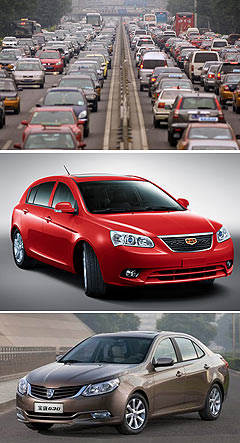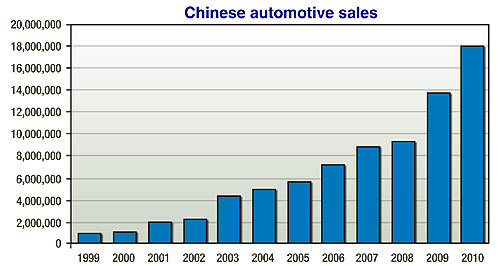Make / Model Search
News - Market Insight - Market Insight 2011China taps the brakes on unbridled growthFull head of steam: The Chinese market is headed towards 20 million this year, thanks to vehicles such as the Chery Tiggo. Car sales set to rise ‘just’ 10-15 per cent in China in 2011 as reins pulled on market18 Jan 2011 CHINA’S motor industry last year found homes for more cars and trucks than any single market in the 125 years of the automobile industry: 18,061,900 vehicles. Soaring past the previous record of 17.9 million set by the United States in 2000, the Chinese market grew 32.3 per cent over last year’s 13.7 million sales. The Chinese Association of Automobile Manufacturers is already tipping the world’s first market of 20 million in 2011. The obvious question is, ‘How long can this bull run last?’ Major cities such as Beijing are already finding ways to discourage their residents from indulging their car ownership fantasies. Beijing has placed restrictions on the number of registrations it will allow within its autonomous region, curbing growth before the capital becomes gridlocked. The Chinese central government – which has built a gob-smacking 74,000km of freeways across the country in the past two decades to accommodate the new obsession with the horseless carriage – has also pulled the brake on growth, axing small-car sales subsidies and rural stimulus incentives as of January 1. Those subsidies were one of the main drivers of the breakneck growth of the Chinese motor industry over the past two years as the government fended off the global financial crisis, so most analysts now expect the heat to come out of the market this year, at least in the cheaper, small-car end of the market (the 70 per cent growth in luxury car sales last year will probably continue regardless into 2011). Incredibly, in a market that has grown ten-fold in a decade, the buzz words being uttered by many observers in the Middle Kingdom now are “over capacity”. Major global automakers and their Chinese partners are almost universally planning fresh factories for China to keep up with the current growth trend. However, the fear now is that growth in production facilities will outstrip the growth in sales. But the car manufacturers will no doubt be difficult to dissuade as they all want to take advantage of the biggest auto sales orgy in history, propelled by relatively cheap labour and a seemingly endless supply of keen, cashed up and not-too-discerning customers.  From top: Beijing traffic, Geely EC7 and Baojun 630. From top: Beijing traffic, Geely EC7 and Baojun 630.Ford, for example, is planning a 50 per cent increase in production capacity in league with its major partner Chang’an Auto. From a standing start two decades or so ago, major car-makers General Motors, Volkswagen, Nissan and Hyundai now sell more vehicles in China than they do in their home markets. Not to mention smaller luxury car-makers such as Rolls-Royce, which sold more than 500 units in China in the first 11 months of 2010 – an increase of 800 per cent. Other giant motor companies such as Toyota and Ford, which were both a bit late to the party, can see their rivals not only making a lot of hay in China but adding huge volumes to their global sales tallies. This threatens Toyota’s grip on the global number one crown, which GM, VW, Hyundai and any number of other companies covet. Last year, Toyota and its local partners sold 846,000 units in China, about half the number of VW, and almost 1.5 million short of GM’s 2.35 million. Worse, its sales growth of 19 per cent was way short of the market average, although its production in China was hurt by labour strikes, as was Honda’s. Expect the world’s number one car-maker to pull out all the stops to make up the lost ground. Of the 30 or so major home-bred Chinese motor companies, all of the biggest and most successful operators have a relationship – often more than one – with international motor companies, building cars under licence and under trusted badges. Also, most of those have some form of state ownership, often from a local province that is hell-bent on ensuring that manufacturing flourishes in their neck of the woods and will bend over backwards to help make it happen. Among the biggest of these operators is Shanghai-based SAIC Motor Corp (partnered with GM and VW, among others), which churned out a whopping 3.58 million units last year, mainly under Buick, Chevrolet and VW badges. Other biggies are Dongfeng with its Nissan, PSA, Kia and Honda relationships, FAW (First Auto Works) coupled with Toyota, Mazda and Volkswagen, BAIC (Beijing Auto) with Hyundai and Mercedes-Benz, and Chang’an Auto (Ford, Mazda, Suzuki). The privately owned companies, such as Great Wall Motors, Geely Automotive, BYD and Chery, by and large trail the joint ventures in the sales race, with Chery selling 682,058 vehicles last year, Geely unloading 415,286 vehicles and Great Wall Motors pumping out 397,300 units (the latter up 77 per cent on 2009). Because the big cities such as Beijing, Shanghai, Chonqing and Guangzhou are edging towards saturation point, car-makers are looking elsewhere for growth, particularly inland regional centres where cars are still relatively rare, and to export markets, where the privately owned Chinese car companies have been most active. This year, Chinese domestic sales are expected to slow from 2010’s 32 per cent growth to between 10 and 15 per cent in 2011, but exports will almost certainly soar as the likes of Chery and Geely widen their global distribution networks from developing markets in Africa, South America and the old Soviet Union to western countries such as Australia. While the brakes might have been tapped on Chinese car sales, it doesn’t mean Chinese motor vehicle production will necessarily slow too.  Read more |
Click to shareMarket Insight articlesResearch Market Insight Motor industry news |











Facebook Twitter Instagram